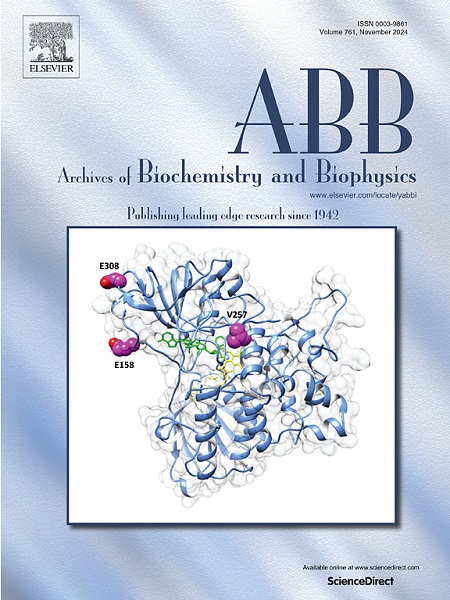High stability of the radical at the catalytic center of cytochrome c oxidase
IF 3.8
3区 生物学
Q2 BIOCHEMISTRY & MOLECULAR BIOLOGY
引用次数: 0
Abstract
In aerobic organisms, cellular respiration is associated with electron transfer through a respiratory system of membrane-bound complexes. This electron flow is terminated by the reduction of dioxygen to water by respiratory oxidases. Cytochrome c oxidase (CcO) is a widely distributed heme-copper-oxygen reductase (HCO) found in all mitochondria and some bacteria. However, the sequential reduction of O2 to water in CcO generates a protein-based radical at the catalytic heme a3-CuB site. To avoid the potential damage from the radical, CcO has apparently developed protective mechanisms. Protection by transfer of the highly oxidizing equivalent over considerable distances away from the catalytic site by redox-active Tyr/Trp chains has been previously demonstrated in bovine CcO. However, the rate of the radical migration from the catalytic center has not yet been determined for any HCO. In this work, we show that the radical escapes from the catalytic center of the ferryl PM intermediate of bovine CcO within minutes, which is much longer than the time of its functional reduction during cellular respiration. Apparently, this high stability has evolved to avoid the dissipation of energy released during the oxygen reduction with substrate electrons.

细胞色素c氧化酶催化中心自由基的高稳定性。
在需氧生物中,细胞呼吸与电子通过膜结合复合物的呼吸系统传递有关。这种电子流通过呼吸氧化酶将二氧还原为水而终止。细胞色素c氧化酶(Cytochrome c oxidase, CcO)是一种广泛分布于所有线粒体和一些细菌中的血红素-铜-氧还原酶(HCO)。然而,在CcO中O2连续还原成水,在催化血红素a3-CuB位点产生一个基于蛋白质的自由基。为了避免自由基的潜在损害,CcO显然发展了保护机制。通过氧化还原活性的Tyr/Trp链将高度氧化的等价物转移到离催化位点相当远的地方进行保护,此前已在牛CcO中得到证实。然而,对于任何HCO,自由基从催化中心迁移的速率尚未确定。在这项工作中,我们证明了自由基在几分钟内从牛CcO的铁基PM中间体的催化中心逃逸,这比它在细胞呼吸过程中的功能还原时间要长得多。显然,这种高稳定性是为了避免氧与衬底电子还原过程中释放的能量耗散。
本文章由计算机程序翻译,如有差异,请以英文原文为准。
求助全文
约1分钟内获得全文
求助全文
来源期刊

Archives of biochemistry and biophysics
生物-生化与分子生物学
CiteScore
7.40
自引率
0.00%
发文量
245
审稿时长
26 days
期刊介绍:
Archives of Biochemistry and Biophysics publishes quality original articles and reviews in the developing areas of biochemistry and biophysics.
Research Areas Include:
• Enzyme and protein structure, function, regulation. Folding, turnover, and post-translational processing
• Biological oxidations, free radical reactions, redox signaling, oxygenases, P450 reactions
• Signal transduction, receptors, membrane transport, intracellular signals. Cellular and integrated metabolism.
 求助内容:
求助内容: 应助结果提醒方式:
应助结果提醒方式:


